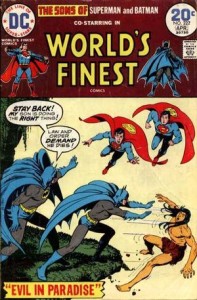I started writing the episodes of the serial with only a few ideas about characters and where I wanted the story to go, but didn’t snag http://wonder-city.dreamwidth.org and start posting until I knew what the ending of the first story arc was going to be. I knew I was going to have a character be my “Maryanne”—who was the innocent, just-come-to-town lead point-of-view character in Tales of the City—and I named her Megan, but she grew as I wrote her in the first draft into the butch, queer, not-quite-eight-foot-tall daughter of a retired superhero named The Amazon. Despite knowing about her first, Megan’s voice was difficult to find, and only really came together in the novel.
I also knew that Ira Feldstein, my octogenarian, Jewish, retired superhero Mister Metropolitan, was going to be a major character, and Ira’s POV voice snapped into place powerfully and immediately. The fact that he was displaced from his own original timeline — or possibly not — came later, with all his fears that maybe he was just “losing it.” My exploration of aging superheroes was not done with Ira; it came back with a vengeance in the third story arc of the serial.
Nereid, believe it or not, was going to be my mean girl. But she fought me mightily, and quickly won the battle. Traces of the mean girl can be spotted in her earliest episodes posted in the serial, and that was one of the things I had to change when I was editing/rewriting bits of the first story arc to turn it into the novel: making Nereid’s character consistent, and show more growth and backbone. Nereid’s character got a major upgrade in the second story arc of the serial—which will be published as a novel called Ephemera in 2016—and I had to reconcile that Nereid with the first novel’s Nereid.
Finally, there was Suzanne Feldstein, Ira’s daughter-in-law, my token non-paranormal POV character. She took some reworking as well for the novel; I wanted her to be a white woman with some clues about the world, but I also wanted to show her as being very stuck in the past. I think I succeeded in getting early Suzanne to move fairly smoothly into the Suzanne we see at the end of the novel, the one who’s trying to get on with her life.
Strong supporting characters I didn’t expect included pretty much everyone, but especially Simon. I adore Simon, my readers adore Simon: I didn’t expect, or even hope for, a Michael Tolliver/Mouse character (one of the best-known and best-loved characters of the Tales of the City books), but I got one anyway.
G originally didn’t work as well as, say, Watson Holmes, so she was kind of a struggle to write. I finally realized why, as I was working my way through the serial. As a result, her story leads into and drives much of the second story arc. Watson has gone on to become one of my favorite recurring characters in the serial, along with her sister Death, who only shows up occasionally, but is awfully memorable when she does appear.
And then, of course, there’s Zoltan, who I loved enough to write an entire novella—”His Faded Idol”—about. That novella may get blown out to novel length before I put it out; I have some ideas about things I’d like to do with it. Hoping for that at the end of 2016 or early 2017. *fingers crossed*
I might start doing more in-depth discussions of some of the characters, or maybe a bit of Wonder City history now. We’ll see what moves me to write in a few days.

